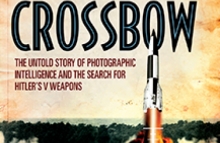New Book Reveals Secrets of Hitler’s V-Weapons
NCAP curator tells of ‘Operation Crossbow’ – one of the great lost stories of the Second World War.
A new book, based on the analysis of once top secret aerial photography held by NCAP, reveals the secrets of Hitler’s V-weapons campaign for the first time. The story of the photographic intelligence unit – the Allied Central Interpretation Unit (ACIU) – is one of the great lost stories of the Second World War.
Operation Crossbow tells for the first time how the secret unit used 3D aerial photographs, now archived in Edinburgh, to hunt for - and help to destroy - the Nazi’s ‘Vengeance’ or V-weapons, before they could be launched against Britain. Author Allan Williams is curator of this archive which holds over 25 million once top secret aerial photographs, taken throughout the Second World War and Cold War. Along with his team, Allan’s ongoing research into the archive represents the legacy of the now-disbanded photographic intelligence unit that was based at RAF Medmenham in Buckinghamshire.
Medmenham’s finest hour began in 1943, during the planning stages of the Allied invasion of Europe, when Wing Commander Douglas Kendall who masterminded the interpretation work at Medmenham, led the hunt for the Vergeltungswaffe – or ‘V’ weapons. The V-weapons, which included the V1 flying bomb and V2 rocket, were a strategic priority for the German high-command, who believed this revolutionary technology could help turn the tide of the war. Remarkably the V2 technology, developed by Dr Wernher von Braun and his team, would later go on to be used by NASA to propel the Apollo spacecraft to the Moon.
In November that year, whilst analysing photographs of Peenemunde in northern Germany, the photographic interpreters spotted a small stunted aircraft on a ramp. This intelligence breakthrough linked the Nazi research station with a growing network of V-weapon launch sites in northern France, Belgium and The Netherlands, where ramps were being constructed aligned not only with London, but a network of targets throughout southern Britain.
Speaking about the book, Allan Williams said Operation Crossbow tells a compelling story about how crucial the work of the reconnaissance squadrons and the interpretation unit was to the outcome of the Second World War. The imagery that survives in the collection relating to Operation Crossbow reveals shows the extent of the search for test and launch sites – which involved taking over 1.2 million aerial photographs – and the great efforts made by the Germans to camouflage the sites. It also tells the story of the dramatic response of the Allied air forces when targets were pinpointed. Without this photographic intelligence – which was created at remarkable speed – the Germans could have launched potentially devastating attacks on Britain before D-Day that could have easily changed the outcome of the war.
Operation Crossbow is published by Preface Publishing, part of the Random House Group, and is available now in hardback and ebook.


